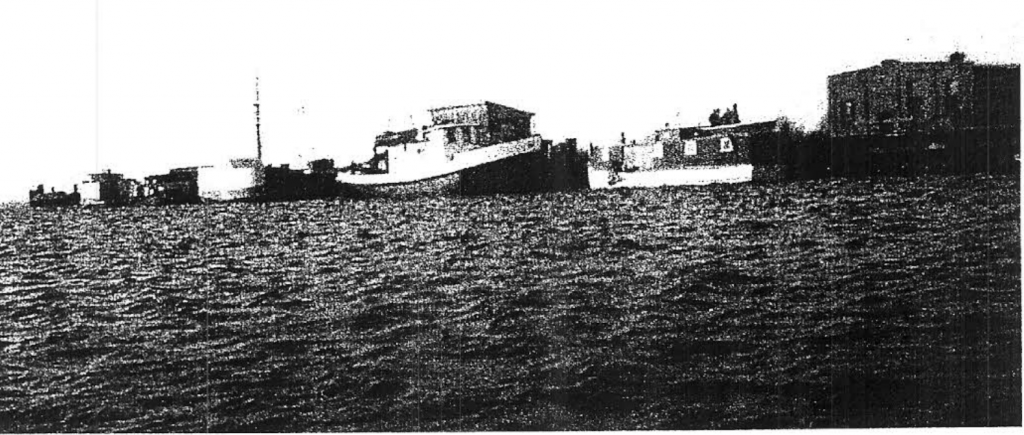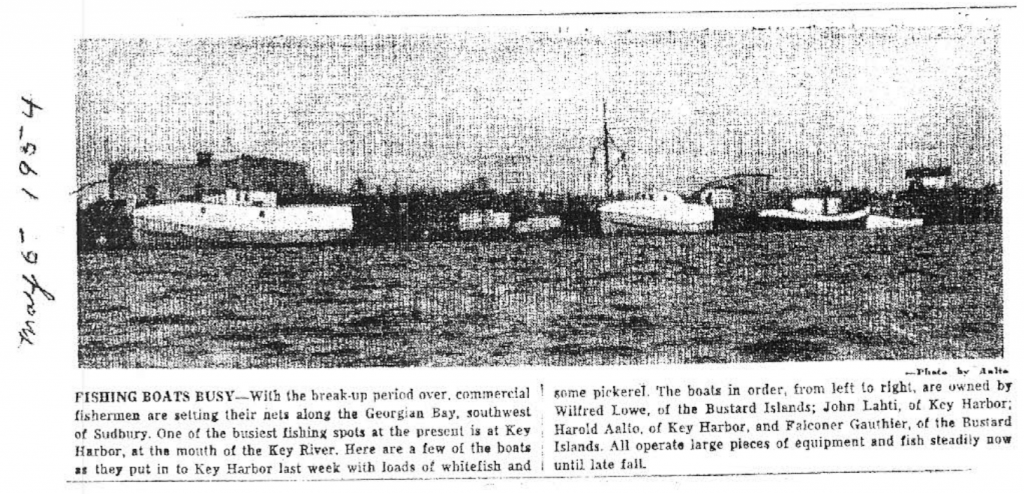From the Summer 2009 edition of the KRAA newsletter. We would like a better copy of this photo for the website, but we do not have one!

The photo, which is above, was given to me by Emily Murray Pillgrem, a true pioneer of the Key. Her father arrived here in 1921 after serving four years and having been gassed in the later part of “The Great War”. His Doctor told him that he needed a dry, cold climate for his health. Emily grew up in Key Harbour, helping her Mom and Dad run the store and post office. I will relate some background on commercial fishing before I tell you about the photo.
With the coming of the railroad to the south end of Georgian Bay in the 1860’s, a route to market was opened up. Rather than having to salt the season’s catch, the commercial fishermen out of Collingwood, Meaford, Owen Sound and area, could move to various fishing grounds further afield and work the waters away from home, still having their fish sent to market in a timely fashion. Those who did, often built fishing stations on the fringe areas of the 30,000 islands.
In our area the largest of these may have been at the Bustard Islands. There were others are the Minks, The Snakes and Champlain Island. The fisherman would move their families to these summer colonies and I can remember my grandmother, Marion Hazzard McKay telling me stories of sailing from Southampton with her father in his two-masted schooner, in the spring, and spending the summer on Green Island in the Bustards where her father fished, and later transported lumber to various ports on Georgian Bay.
Another well known family at the Bustards in the late 1800’s was the Pillgrem family, located first on Meaford Island and later on Highlander Island. The Dominion Fish Company was also situated in the Bustards. They had a base on Rideout Island. Supplies for the fishermen and families came on regularly scheduled runs by the steamers Manitou and Caribou, owned and operated by the Dominion Fish Company which was a Canadian subsidiary of the Booth Fisheries Corporation of Chicago. The main function of it’s vessels was to carry supplies to the many small fishing villages on the Bay and Lake Superior, and to carry their fish to the nearest rail lines for quick transport to United States markets. Of course, the steamers would carry what ever else came their way. A by-product of the fishing industry was fish oil. The fish entrails were boiled down in huge vats to render the oil. The oil was sold in Toronto for $10.00 to $12.00 a barrel. Much of the fish, on the other hand, was sold to agents of American companies.
As the boats came in from fishing grounds, they were loaded and the fish dressed and packed in ice in wheeled boxes, each of which contained 1200 pounds. These were put on the steam tugs which carried them away. Trout and whitefish were the usual varieties caught, but the fall pickerel were worth more per pound than any other fish because they could be shipped without first being dressed.
Fish began to be shipped out of Key Harbour by rail in the early 20’s using the “Jitney”.
We are not sure when the above photograph was taken but you can see by the number of tugs at the dock that the commercial fishing was in full swing. The picture was taken in the 50’s.
The commercial fisherman during that time frame were the Aaltos and Lahtis, located at Key Harbour and in the Finn’s Channel. Ellicot and Light, then Light and Moody on Champlain Island, Pillgrem Bros., Wilfred Lowe, Clem Lougheed from the Bustards, and C.H. Gauthier Fisheries out of the Bad River. I think the most easterly or right had boat tied to the coal dock is the Ruth M belonging to Pat Mclntosh. She was a wooden boat with a white hull and green cabin. He used her for delivering gas and propane to the various camps in our area. He had used her for fishing in earlier times. The next in line could be the Edith G Gauthier’s new fish tug. Bill Belanger, General Foreman, had given my Mom and Dad and I a tour of the steel tug and she had all the latest equipment. Mr. Belanger was very proud of her. The other boats must belong to the fishermen in our area during that time.
You can see how far the coal dock extends out into the Bay and the boom which was used to lift the fishing boxes out of the boat and onto the flat cars and were then pulled to Key Junction by the “Jitney” to be loaded into CN refrigerator cars.
After I had written the foregoing, I kept thinking that I had seen the photograph before! I spent the afternoon searching through all my papers, scrapbooks, and picture albums and voila, guess what I found? This photo and write-up was in the newspaper in the Sudbury Star, dated May 5, 1954. My mother had cut it out and written the date on the side.

Notice the photo was taken by “Aalto”. We now know who the tugs belonged to and the date of the picture.
And so it was… most fisheries became dormant by 1960. The abandonment if the Key Harbour Branch and Spur Line was completed in September 1960. Any commercial fish still being caught are shipped from Britt by highway, in refrigerator trucks.
Acknowledgements: